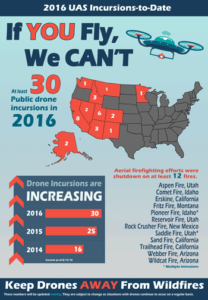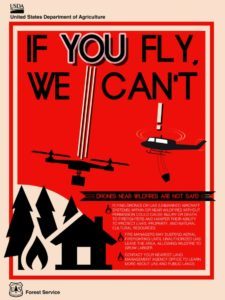Guest post by Jeremiah Karpowicz, Commercial UAV News
Regardless of how many times a particular headline appears, it can feel like certain stories are being published on a daily basis. Not too long ago, news of the “drone” that hit an airplane felt like it was everywhere. Unfortunately, the update that clarified it was just a plastic bag wasn’t quite as pervasive.
A different kind of story has been dominating the headlines lately, but it isn’t the sort of thing that’s going to be debunked or disproven. Whether it’s operators flying over wildfires in California, Arizona, or elsewhere in the United States, drones are causing serious issues for emergency response professionals, and the problem is both very real and getting worse. By all accounts there have been many more issues in 2016 than there were in 2015.
This is a major issue for multiple reasons, the most prominent being the lives that are put in further danger when emergency professionals can’t take to the sky and do their job because someone is illegally in the airspace. Additionally, that delay can cause much more severe damage to the area, and cause wildfires to last that much longer.
Also concerning is damage that is being done to the reputation of the technology. Such things pale in comparison to the real world losses, but it’s discouraging to think that officials are seeing the damage done by drones and in turn want nothing to do with the technology. Luckily, at least in the case of the U.S. Forest Service, that is not the case. In fact, the U.S. Forest Service has and continues to take a very progressive approach to UAV technology. However, none of that is as important as highlighting the simple fact that if someone is flying their drone near an emergency situation, they will be preventing emergency professionals from doing their jobs.
Protecting the Land from the Sky
The U.S. Forest Service manages the nation’s forest and grasslands across the country, and the agency also has either a direct or indirect role in stewardship of about 900 million forested acres within the U.S. Those forests and grasslands catch fire, whether that’s through natural causes like lighting, or human causes, so fire suppression is a pretty big part of their mission.
“Fire is a natural part of many of our ecosystems and can provide a number of benefits,” said Jennifer Jones, Public Affairs Specialist for the U.S. Forest Service. “However, there are areas where we have communities located or other values at risk, so actually putting out fires is a lot of what we do.”

There’s nuance in their approach though, as there are around 44 million homes in the wildland urban interface, which are areas located within or adjacent to forest and range lands. When those areas catch fire, the U.S. Forest Service is there to protect life, property, community and infrastructure as well as natural resources. Sometimes that can mean allowing a fire to play a natural role in the environment, but their mission is around sustaining the health, diversity and productivity of the nation’s forests and grasslands.
Managing and fighting those fires is something they do from the air as well as the ground, which is why the U.S. Forest Service operates more aircraft than any agency besides the Department of Defense. The agency has well over 100 helicopters on exclusive use contracts, which means they’re available for fire suppression on a continuous basis. They also use fixed wing aircraft to drop fire retardant on fires as well as to map, detect and assess the condition of those lands.
Suffice to say, the U.S. Forest Service uses aircraft for a variety of purposes, and in fact they first tested unmanned aircraft in the Lolo National Forest on a prescribed fire in 1996. However, the technology has only recently presented them with a new type of challenge.
Drones and Wildfires
Issues with members of the public flying drones of their own over wildfires first came up for the U.S. Forest Service in a real way in 2014. There were a handful of instances that year, but those numbers dramatically increased in 2015. That increase has continued in 2016, as they’ve been able to document at least 27 instances of members of the public flying drones over fire, and in at least 18 of those cases fire managers temporarily suspended aerial firefighting operations. These instances were detailed in various ways, but without any kind of national centralized reporting database, there are undoubtedly more that haven’t been documented.
While it’s not official policy to stay out of the air when an undocumented aircraft appears, it’s an action that fire managers can choose to take and often do choose to take. That’s understandable not only because of the uncertainty around what those aircrafts are going to do, but because they’re literally occupying the same airspace.
“What you also have to remember is that our aerial firefighting aircraft are flying very low,” said Jones. “Both the helicopters and our airtankers are just a couple hundred feet above the ground, which puts them in the exact same airspace that the FAA mandates for hobby and recreation drones. That creates a serious concern for a mid-air collision that could be serious and even fatal not only to our people in the air but to anyone on the ground. It’s a very real hazard.”
U.S. Forest Service aircrafts are flying in smoky, windy, turbulent, conditions. Safety in that space really depends on knowing where other aircrafts are and being able to communicate with them. The sudden appearance of a drone means those emergency responders don’t know where that drone is going or have any means of communicating with it. Pilots have no idea who’s flying that drone, or what it’s going to do next. Some operators don’t realize their drone is considered an aircraft and there are specific FAA guidelines for operating a UAV recreationally and commercially. Regardless of how a drone is being used, operators need to realize that despite their size and the ease in which they can take to the air, restrictions like TFR’s (temporary flight restriction), which manned pilots need to look for and abide by, apply to them.
Separate Issues
Seeing all the problems that the technology is causing the U.S. Forest Service would probably make you think the agency has developed a negative attitude toward drones, but that’s actually not the case. They fly numerous manned aircrafts for a variety of natural resource management purposes, and they’ve recognized the kind of impact drones can have around enhancing safety and lowering costs. “We are very interested in using drones, and we’ve been doing a lot of things to enable our agency to do that,” Jones mentioned. “These problems we’re having with the public flying drones over fires are not in any way creating a negative feeling about the U.S. Forest Service using them ourselves. We are very much interested in using drones and have a number of efforts underway to enable them to happen in the future.”
As mentioned earlier, the U.S. Forest Service has been experimenting with using drones since 1996, and over the last couple years they’ve taken additional steps to integrate UAVs into their operations. Potential missions that UAVs could be used for include forest, soil and air management. Drones could also change their approach around fire and aviation management plus their burned area emergency response. A number of the different ways the U.S. Forest Service could use UAVs have been identified in detail, and they’ve already begun to move forward with many of those efforts.
In 2015, the U.S. Forest Service used a UAV in Alaska to conduct a bridge inspection. They’ve flown UAVs on a couple fires last year and also one this year in New Mexico. They’ve contracted a company to fly a UAV on their lands to conduct a natural resource management mission in the forest health protection area. They’re also going to be doing some surveys with drones to detect insect damage. Like many professionals, U.S. Forest Service officials are working through issues associated with logistics. How do they store their data? How do they develop standards? Should they own their own UAVs, or work with partners and contractors? They’re currently doing a lot of work to develop a safe and cost effective program for UAVs.
Some might view this embrace of the technology as a mixed message. Others have actually asked why U.S. Forest Service officials can fly over wildfires while members of the public cannot. The obvious answer there has to do with FAA regulations and TFRs, but an even more obvious answer would be about giving people who are there to save lives priority over people who are there to take pictures. Even if we leave all of that aside, officials can and do operate drones in these situations because they know what these drones are doing and how to communicate with them. They coordinate their efforts and take a number of other steps to de-conflict the airspace. When a public drone shows up unexpectedly, it creates a whole different scenario.
“If You Fly We Can’t”
Aviation is the riskiest thing the U.S. Forest Service does in fire management. Over the last ten years, about half of their wildland firefighter fatalities were aviation related. It’s a huge number, and it’s the main reason they’ve looked so closely at UAV solutions. It’s also the main reason they’re so cautious when it comes to grounding firefighting operations when a drone flies into their airspace. When members of the public fly their drones over a wildfire or other emergency situations, they’re creating additional risk for the people who are trying to mitigate that incident.

“We can understand the attraction for most of the people engaging in this,” Jones concluded. “If you have a drone that takes video or photographs, wildfires are a great subject. You get some great aerial shots. The issue is that most people are unaware of the safety risk they’re creating, and from our standpoint there would be nothing more tragic than someone who’s just trying to get a good photo causing a mid-air collision that kills people. That’s why we’ve put so much effort into educating the public.”
Those public education efforts are focused around the “If You Fly We Can’t” campaign, which sums up the issue quite succinctly. Flying into or over emergency situations with an unauthorized drone can cause fires to grow larger and further threaten people and property. This exact issue cropped up in San Diego in August of 2015 when there were cars catching fire on both sides of the freeway. Several drones were flying above the fires, and aerial firefighting operations had to be grounded. Firefighters and people whose lives were being threatened by that fire were put in further danger because of those unauthorized drones.
While anyone who operates a drone in this manner exposes themselves to fines and potentially criminal prosecution for interfering with firefighting operations, it’s the practical repercussions that should be the most relevant to everyone. One of the best places to see how this is impacting people on all sides of the issue is by looking at the #ifyouflywecant hashtag on Twitter, where you can find social media posts from a number of different agencies on this topic.
There are clearly challenges when it comes to education and awareness around how the public can operate their drones, but it’s great to know those challenges aren’t impacting the way officials are approaching using drones themselves. The U.S. Forest Service devotes a serious amount of time to planning and coordinating how they’re going to operate their drone. Anyone who doesn’t probably needs to seriously consider how, when, where and if they can take to the sky in order to know that they’re not putting other people or even themselves at risk.
Source link
 Unmanned Aerial Vehicle The latest drone news
Unmanned Aerial Vehicle The latest drone news



